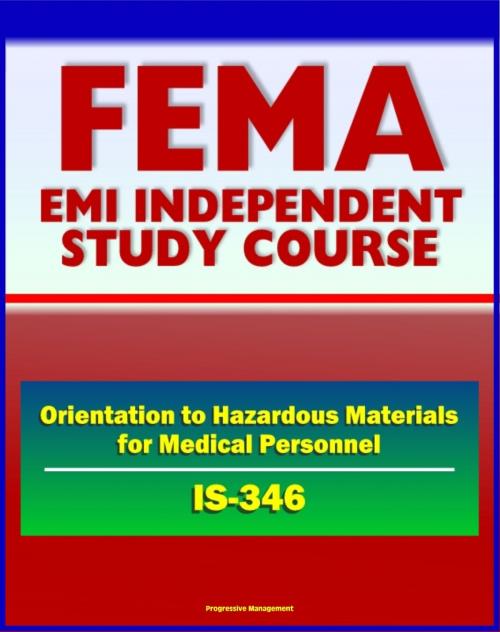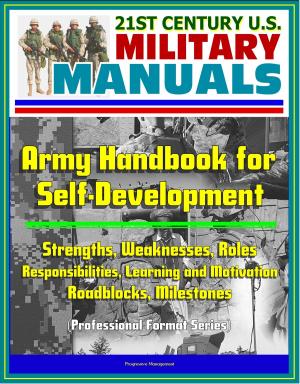21st Century FEMA Study Course: An Orientation to Hazardous Materials for Medical Personnel (IS-346)
Nonfiction, Social & Cultural Studies, Political Science| Author: | Progressive Management | ISBN: | 9781465804440 |
| Publisher: | Progressive Management | Publication: | July 7, 2011 |
| Imprint: | Smashwords Edition | Language: | English |
| Author: | Progressive Management |
| ISBN: | 9781465804440 |
| Publisher: | Progressive Management |
| Publication: | July 7, 2011 |
| Imprint: | Smashwords Edition |
| Language: | English |
This Federal Emergency Management Agency (FEMA) independent training course manual from the Emergency Management Institute (EMI) will provide you with a general understanding of the terms and concepts related to hazardous materials and radiation. It also covers some basic principles regarding hospital personnel’s response to hazardous materials incidents.
This course, An Orientation to Hazardous Materials for Medical Personnel, contains five units, a final examination, and several appendices including a glossary.
Unit 1: Course Introduction - This unit provides details on how to complete the elf-study course and an overview of the course. It also describes the medical center or hospital’s involvement in hazardous materials events and response efforts, and explains the importance of compliance with federal, state, local, and tribal regulations and standards.
Unit 2: Types and Sources of Hazards - This unit describes the Department of Transportation’s hazardous materials classes and identifies the sources of potential hazards in the home, workplace and community. It also describes the possible mechanisms of harm for hazardous materials classes.
Unit 3: Planning for Response - This unit reviews the regulatory requirements regarding medic al facilities’ and hospitals’ emergency/disaster response plans, discusses the staffing resources required to develop a plan and familiarizes you with the basic requirements of a plan.
Unit 4: Responding to Hazards This unit provides details on how to prepare to receive patients and describes the roles and responsibilities of the key team members of an emergency response team. It also provides details on how to prepare an emergency area and how to prepare the emergency response team. You will also learn about the basic principles regarding hospital emergency department management such as patient assessment and triage, treatment of contaminated patients and decontamination procedures. Finally, this unit describes sources of information on hazardous materials.
Unit 5: Introduction to Radiation - This chapter identifies sources of radiation and presents data on the frequency of radiation accidents. It describes the types of radiation injuries and provides an overview of radiation physics. This unit also describes how to measure radioactivity and the types of instruments used to measure it, defines basic radiation protection principles, and presents the recommended radiation exposure limits. It also covers basic biological effects of ionizing radiation in order to provide a foundation for understanding the clinical aspects of radiation injuries.
This is a privately authored news service and educational publication of Progressive Management.
This Federal Emergency Management Agency (FEMA) independent training course manual from the Emergency Management Institute (EMI) will provide you with a general understanding of the terms and concepts related to hazardous materials and radiation. It also covers some basic principles regarding hospital personnel’s response to hazardous materials incidents.
This course, An Orientation to Hazardous Materials for Medical Personnel, contains five units, a final examination, and several appendices including a glossary.
Unit 1: Course Introduction - This unit provides details on how to complete the elf-study course and an overview of the course. It also describes the medical center or hospital’s involvement in hazardous materials events and response efforts, and explains the importance of compliance with federal, state, local, and tribal regulations and standards.
Unit 2: Types and Sources of Hazards - This unit describes the Department of Transportation’s hazardous materials classes and identifies the sources of potential hazards in the home, workplace and community. It also describes the possible mechanisms of harm for hazardous materials classes.
Unit 3: Planning for Response - This unit reviews the regulatory requirements regarding medic al facilities’ and hospitals’ emergency/disaster response plans, discusses the staffing resources required to develop a plan and familiarizes you with the basic requirements of a plan.
Unit 4: Responding to Hazards This unit provides details on how to prepare to receive patients and describes the roles and responsibilities of the key team members of an emergency response team. It also provides details on how to prepare an emergency area and how to prepare the emergency response team. You will also learn about the basic principles regarding hospital emergency department management such as patient assessment and triage, treatment of contaminated patients and decontamination procedures. Finally, this unit describes sources of information on hazardous materials.
Unit 5: Introduction to Radiation - This chapter identifies sources of radiation and presents data on the frequency of radiation accidents. It describes the types of radiation injuries and provides an overview of radiation physics. This unit also describes how to measure radioactivity and the types of instruments used to measure it, defines basic radiation protection principles, and presents the recommended radiation exposure limits. It also covers basic biological effects of ionizing radiation in order to provide a foundation for understanding the clinical aspects of radiation injuries.
This is a privately authored news service and educational publication of Progressive Management.















